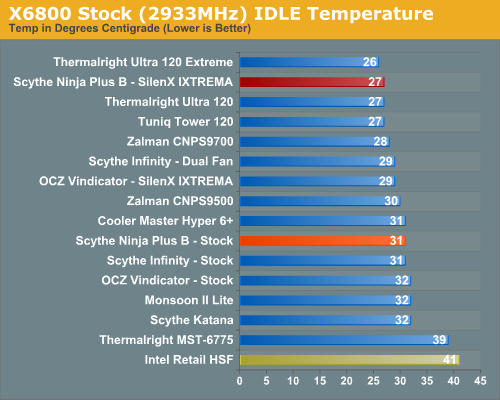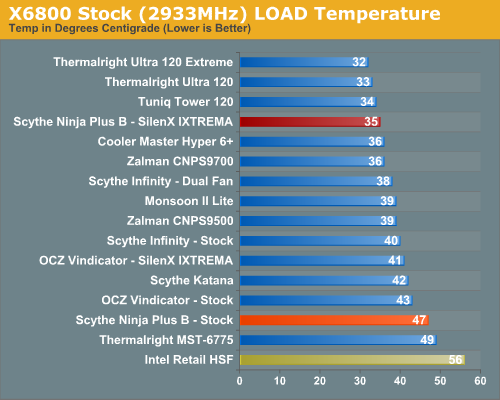Scythe Ninja Plus Rev. B: Updated Cooling Legend
by Wesley Fink on April 11, 2007 2:00 AM EST- Posted in
- Cases/Cooling/PSUs
Cooling at Stock Speed
Some users will never overclock their CPU, but they still want to run the coolest CPU temperatures possible to enhance stability and extend CPU life. The Scythe Ninja Plus B kit includes a moderate output low noise 120mm fan. We also tested the Vindicator with the 120mm SilenX IXTREMA 120 fan.

With the stock fan the end user does get relative silence, but the cost is poorer cooling than most other heatpipe towers tested at AnandTech. As soon as the switch is made to the SilenX fan you can see this cooler is starved for airflow with the stock fan. Idle temps with the SilenX drop to 27C, which is among the best measured performance at stock Idle in our cooler reviews
It is more difficult to effectively simulate a computer being stressed by all of the conditions it might be exposed to in different operating environments. For most home users CPU power is most taxed with contemporary gaming. Therefore our stress test simulates running a demanding contemporary game.
The Far Cry River demo is looped for 30 minutes and the CPU temperature is captured at 4 second intervals with the NVIDIA monitor "logging" option. The highest temperature during the stress test is then reported. Momentary spikes are ignored, as we report a sustained high-level temp that you would expect to find in this recording configuration.
Cooling efficiency of the Scythe Ninja Plus B was tested under load conditions with both the stock fan and the SilenX at stock speed. Results are compared to the Intel retail HSF and other recently tested CPU coolers.

The Ninja Plus B under load at stock speeds reached a maximum temperature of 47C with the stock cooler. This was among the worst load results at stock speed with the coolers tested at AnandTech. Switching to the SilenX fan improved the load temperature to 35C. This is a stellar result, and one of the best stock speed load temperatures we have tested. This compared to the Tuniq at 34C, the Cooler Master Hyper 6+ and Zalman 9700 at 36C, the Thermalright Ultra 120 at 33C , and the top Ultra 120 Extreme at 32C.
It should also be clear that cooling results with the Scythe Ninja Plus B are quite different than results with the OCZ Vindicator using the same SilenX fan. The Ninja Plus B cools better than the Vindicator using the same fan. This strongly suggests that while the Vindicator looks similar it is not just a rebadged Scythe Ninja Rev. B. There are enough differences in their designs to have an impact on cooling performance. This becomes clearer in a closer look at cooler performance scaling.
Some users will never overclock their CPU, but they still want to run the coolest CPU temperatures possible to enhance stability and extend CPU life. The Scythe Ninja Plus B kit includes a moderate output low noise 120mm fan. We also tested the Vindicator with the 120mm SilenX IXTREMA 120 fan.

With the stock fan the end user does get relative silence, but the cost is poorer cooling than most other heatpipe towers tested at AnandTech. As soon as the switch is made to the SilenX fan you can see this cooler is starved for airflow with the stock fan. Idle temps with the SilenX drop to 27C, which is among the best measured performance at stock Idle in our cooler reviews
It is more difficult to effectively simulate a computer being stressed by all of the conditions it might be exposed to in different operating environments. For most home users CPU power is most taxed with contemporary gaming. Therefore our stress test simulates running a demanding contemporary game.
The Far Cry River demo is looped for 30 minutes and the CPU temperature is captured at 4 second intervals with the NVIDIA monitor "logging" option. The highest temperature during the stress test is then reported. Momentary spikes are ignored, as we report a sustained high-level temp that you would expect to find in this recording configuration.
Cooling efficiency of the Scythe Ninja Plus B was tested under load conditions with both the stock fan and the SilenX at stock speed. Results are compared to the Intel retail HSF and other recently tested CPU coolers.

The Ninja Plus B under load at stock speeds reached a maximum temperature of 47C with the stock cooler. This was among the worst load results at stock speed with the coolers tested at AnandTech. Switching to the SilenX fan improved the load temperature to 35C. This is a stellar result, and one of the best stock speed load temperatures we have tested. This compared to the Tuniq at 34C, the Cooler Master Hyper 6+ and Zalman 9700 at 36C, the Thermalright Ultra 120 at 33C , and the top Ultra 120 Extreme at 32C.
It should also be clear that cooling results with the Scythe Ninja Plus B are quite different than results with the OCZ Vindicator using the same SilenX fan. The Ninja Plus B cools better than the Vindicator using the same fan. This strongly suggests that while the Vindicator looks similar it is not just a rebadged Scythe Ninja Rev. B. There are enough differences in their designs to have an impact on cooling performance. This becomes clearer in a closer look at cooler performance scaling.










36 Comments
View All Comments
Pirks - Wednesday, April 11, 2007 - link
I'm going to get myself a monster of a heatsink called Cooler Master GeminII. It has two 120mm fans on top that blow right down on the mobo. On the other hand I keep reading all these news here coming from Gary, Wesley, Jarred and the gang, that tower coolers like Infinity or Thermalright kick ass and yield only to waterblocks. Now, the question is - are you guys really missing this important part of cooling mosfets, power circuitry, some northbridge, memory etc? Or is it really unimportant?I mean, what's the point in having such an imbalanced cooling solution where the CPU is cool but evetything else is almost melting? I recall my experience with Athlon XP in a tight poorly ventilated case - I put Zalman on it instead of a little tower HSF and you you know what? The power circuitry temperature went down 16 degrees right there, and I stopped getting Windows freezing on me. Stability became just like on those pesky Macs (j/k) :)
So what is it? A vertical tower? Or a horizontal cooler that blows on mosfets? Or a mix of both with tower and additional coolers around it to cool mosfets?
At least a link to some systematic research won't hurt, I can only see opinionated forums where half of the population says towers suck because they don't cool mosfets and the other half says towers rock precisely because they don't cool mosfets :) Wesley? Gary? Any other AT overclocking guru? What's your opinion and arguments for it (or against it)?
LaGUNaMAN - Thursday, April 12, 2007 - link
Speaking of the Cooler Master GeminII, requesting to have that reviewed as well. Great job on the article BTW Bozz Wesley. Can't wait for the 120mm fan roundup. (^^,)Wesley Fink - Friday, April 13, 2007 - link
The CoolerMaster Gemini II is in the lab for review. I agree it looks really promising with a pair of low-noise high-output fans. We hope to get to it within the next couple of weeks.Kaleid - Saturday, April 14, 2007 - link
Could you try placing one fan in the middle of that cooler? Does it really perform better with two fans or would one silent fan do the trick?Stele - Wednesday, April 11, 2007 - link
That's a very good question, one which I've often asked myself when looking for coolers. Granted, a straight-through airflow right out the back of the casing helps prevent a build-up of warm air inside it, but that would leave a weak level of airflow around the other hotspots on the motherboard... especially with the likes of a 680i SLI overclocked.
It would be terrific if Anandtech could deploy a few thermocouple probes or even an IR thermometer and measure the temperatures of those hotspots - PWM heatsink (or PWM MOSFET if no heatsink present), northbridge, and if time allows, perhaps even the side of a RAM DIMM and graphics card nearest the CPU socket area. That would certainly help differentiate the coolers good at just cooling the CPU from those that can do better overall. :)
noobzter - Wednesday, April 11, 2007 - link
1. How does the CPU temp as reported in NTune compare to TAT's?2. What was the ambient temp during the test?
noobzter - Thursday, April 12, 2007 - link
Sweet, thanks!Wesley Fink - Thursday, April 12, 2007 - link
TAT workload testing with the stock Scythe fan on the Ninja Plus B show test results virtually the same at TAT 80% CPU load as our 30 minute gaming tests. Since you are likely familiar with TAT results that info may be useful. TAT does stress both cores in testing, which our current game tests do not do.Wesley Fink - Thursday, April 12, 2007 - link
1. TAT (Thermal Analysis Tool) is an Intel program, so it did not occur to us to use it for verification on an nVidia chipset. However, it is CPU centric, and we found it DOES work on the 680i chipset. Comparing Idle temps to nVidia Monitor results at 3.73GHz overclocked showed reported Monitor and TAT temps within 0-2C of each other. We will test more with TAT using internal load tests in the future.2. Ambient room temperature during tests is 70F (21C).
iluvdeal - Wednesday, April 11, 2007 - link
I am looking for a quiet HSF which allows good OCing for a Core2Duo and the Ninja fits that bill, however the one thing that's constantly repeated about it is it's difficult to securely mount with a S775. That's what scared me away from it.